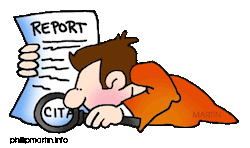Academic Honesty
- Academic honesty entails giving credit to the sources you used to support a project or written work.
- Download St. George’s Code of ethical conduct.
Citations
- A citation is a way of giving credit to the original source of a creative or intellectual work you used in your paper or project.
- Makes your paper look stronger, more scholarly, and more credible.
- Gives credit to the original author of the quotation or the idea.
- Allows your readers to find the resources you used in your research.
- When you use the exact words or paraphrase the words of another author.
- When you use or summarize the ideas or work of another author.
- When you use widely known and accepted knowledge.
- When you use easily verifiable facts.
- Title
- Author
- Date of publication
- Page number/s (for print resources)
- Date of access (for electronic resources)
- Name, date, and venue (for interviews)
- There are several styles used to cite sources that all do the same thing with different rules for formatting (italics, parentheses, quotation marks, abbreviations, etc.).
- Common styles are MLA, Harvard, and APA.
- St. George’s International School recommends using the MLA style of referencing.
- For examples of how to create citations for some common types of sources, see MLA.
Citing Sources “In-text”
- An in-text citation tells your reader that you are using intellectual or creative work from another source. It refers the reader to information about your source, which is contained elsewhere in your paper.
- MLA referencing style uses parenthetical in-text citations, which include the name of the creator and a page number in parentheses.
- A parenthetical in-text citation must be accompanied by a corresponding entry in your Works Cited list.
- For examples of how to create in-text citations for some common types of sources, see MLA.
Reference Lists, Works Cited Lists, and Bibliographies
- Includes only works that you cited in your paper.
- Appears at the end of your paper.
- Works are arranged alphabetically, beginning with the first letter of each entry (regardless of whether it’s a name, and organization, or a title).
- (Same as a “Works Cited” list.)
- For examples of how to create a References list in MLA style, see MLA.
- Includes only works that you cited in your paper.
- Appears at the end of your paper.
- Works are arranged alphabetically, beginning with the first letter of each entry (regardless of whether it’s a name, and organization, or a title).
- (Same as a “References” List.)
- For examples of how to create a Works Cited list in MLA style, see MLA.
- Includes all the sources you read to prepare for your paper. [Confusingly, the IBO requires a “Bibliography” in the Extended Essay. But you must include only the works cited in your paper (see Criteria A & D).]
- Appears at the end of your paper.
- Works are arranged alphabetically, beginning with the first letter of each entry (regardless of whether it’s a name, and organization, or a title).
- For examples of how to create a Bibliography in MLA style, see MLA.
Credibility clues
- Credibility: Look for verifiable information about the author or editor. Beware of goofy, frivolous, or misleading URLs & domain names. Extensions .gov and .edu are credible.
- Accuracy: Up-to-date, no grammatical errors, information can be found other information sources.
- Reasonableness: Beware of clickbait, distracting or unidentified advertisements, inflammatory language, satire, or political or religious affiliations.
- Support: Look for supporting evidence, scientific data, hyperlinks, or bibliography.
CARS test
Use the CARS checklist to evaluate internet resources:
- Credibility
- Accuracy
- Reasonableness
- Support
Spotting fake news
Don’t be fooled! Think critically about the news you read.


Get Social